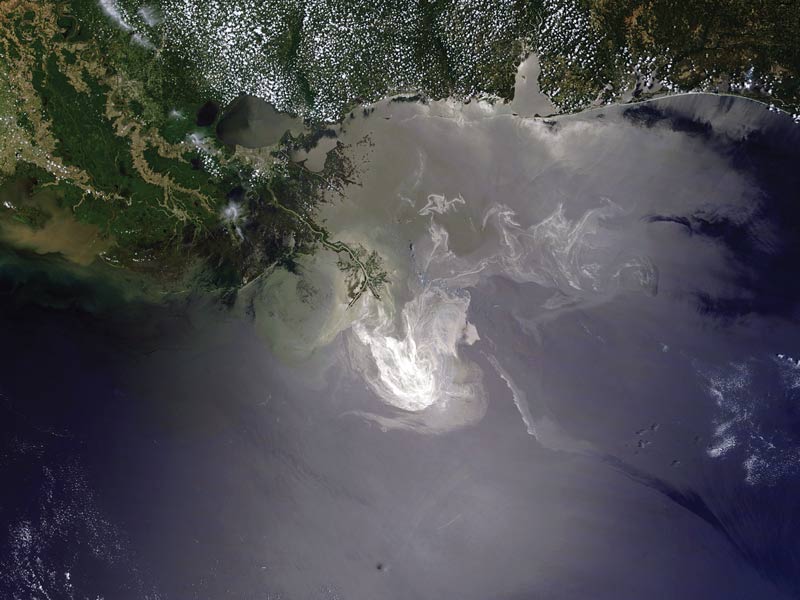Spotting and Measuring Oil Spills
Spring
2015
Building Blocks - Undergraduate Research and Outreach Projects
Spotting and Measuring Oil Spills
New technologies under development at Saint Peter’s University
By:Prajwal Niraula, Class of 2015, and Sabin Pradhan, SPS Chapter President,
Class of 2016, Saint Peter’s University, Jersey City, NJ
Saint Peter's University

On April 20, 2010, a violent explosion occurred at the oil-drilling rig Deepwater Horizon in the Gulf of Mexico. A sludge of mud, oil, and water poured out of the well, shooting high into the sky. A fire broke out and claimed the lives of 11 people. The oil poured out for months in what would go down as the largest marine oil spill in the history of petroleum drilling.[1]
At Saint Peter’s University, the Society of Physics Students chapter is using an SPS Chapter Research Award to explore technologies that could help to prevent or minimize the impact of accidents like the one at Deepwater Horizon. We are exploring the potential of infrared cameras for early oil spill detection and remote measurement of an oil spill’s volume. Such technologies are important because they could detect early failures in equipment and operations, and inform response teams about the best course of action. Even though alternative energy sources have been developed, it is very likely that the world will continue using fossil fuels for decades to come to meet high energy demands.
Infrared technology
Every object, whether hot or cold, emits radiation. The nature of this radiation is governed by Planck’s radiation law, which says that the spectrum of radiation emitted by an object depends only on its temperature. For bodies at room temperature, the dominant form of emission occurs in the infrared region at wavelengths ranging from about 700 nm to 1 mm. This radiation is invisible to us because our eyes respond only to light in the visible spectrum, the narrow window of about 400–700 nm. Infrared technology allows us to detect radiation in the infrared region and thus determine the temperatures of objects.
The apparent temperature of a substance depends on its emissivity, and oil and water have slightly different emissivities. Therefore, even when oil and water are in thermal equilibrium, an infrared camera is able to detect two distinct liquids.
We showed that this contrast can be used to easily find the total area of a puddle of oil floating on water. This means that oil should be detectable by an infrared camera, even when visibility conditions for the human eye are poor.
We also wanted to explore techniques for finding the thickness of a puddle of oil so that we could determine the total quantity spilled. We attempted to find a relationship between thickness and emissivity but found no measurable relationship within the range our camera can detect, forcing us to turn to other means.
Oil Fluorescence
Dr. Clyde Bethea and Dr. Debing Zeng, who were advising our team at the time, encouraged us to look into the fluorescence property of our oil samples. Fluorescence occurs when an object absorbs a fraction of the incident light striking it and emits the energy as light with a longer wavelength after a brief interval of time.[2]
We recorded the fluorescence of three different oil samples, using an incident laser with a wavelength of 405 nm. The oil samples, distinguishable to the eye by their color, also had unique fluorescence spectra. We attributed these signature spectra to the nature of the chemical bonds in each sample.
Since fluorescence spectra are unique for different oils, they can be used to detect the type of oil spilled. They also greatly minimize the chance of a false alarm about a spill by providing a more rigorous test for oil detection than infrared cameras, which show only the contrast between two materials and cannot be used to identify the constituents themselves.
Fluorescence can also be used to measure the thickness of a layer of oil. Water is fairly transparent to laser light, while oil is not. The thicker the layer of oil floating on the surface of water, the more laser energy it should absorb and emit. We exploited this relationship to qualitatively measure oil heights.
We used laser pointers operating on batteries for this measurement. However, the batteries drained quickly and the power gradually decreased. To quantify layers of oil thicker than a few microns, we needed a constant-power laser. Fortunately we were recently able to purchase one and are looking forward to exploring this further during the spring semester.
References
1. The Gulf Oil Disaster and the Future of Offshore Drilling. National Commission on the BP Deepwater Horizon Oil Spill and Offshore Drilling. January 2011.
2. S. R. Swift and L. Trinkle-Mulcahy. Basic Principles of FRAP, FLIM, and FRET. Source: http://www.trinklelab.com/pubpdf/04/rms04.pdf.
More from this department
Building Blocks - Undergraduate Research and Outreach Projects
